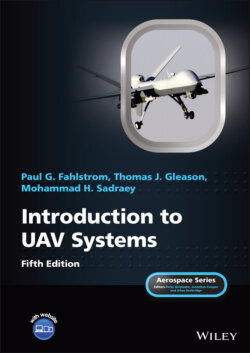Читать книгу Introduction to UAV Systems - Mohammad H. Sadraey - Страница 16
1 History and Overview 1.1 Overview
ОглавлениеThe first portion of the chapter reviews the history of UAV systems from the earliest and crudest “flying objects” through the events of the last decade, which has been a momentous period for UAV systems.
The second portion of the chapter describes the subsystems that comprise a complete UAV system configuration to provide a framework for the subsequent treatment of the various individual technologies that contribute to a complete UAS. The air vehicle itself is a complicated system including structures, aerodynamic elements (wings and control surfaces), propulsion systems, and control systems. The complete system includes, in addition, sensors and other payloads, communication packages, and launch and recovery subsystems.
Finally, a cautionary tale is presented to illustrate why it is important to consider the UAV system as a whole rather than to concentrate only on individual components and subsystems. This is the story of a UAS that was developed between about 1975 and 1985 and that may be the most ambitious attempt at completeness, from a system standpoint, that has so far been undertaken in the UAS community.
It included every key UAS element in a totally self‐contained form, all designed from scratch to work together as a portable system that required no local infrastructure beyond a relatively small open field in which a catapult launcher and a net recovery system could be located. This system, called the Aquila remotely piloted vehicle (RPV) system, was developed and tested over a period of about a decade at a cost that approached a billion dollars. It eventually could meet most of its operational requirements.
The Aquila UAS turned out to be very expensive and required a large convoy of 5‐ton trucks for transportation. Most importantly, it did not fully meet some unrealistic expectations that had been built up over the decade during which it was being developed. It was never put in production or fielded. Nonetheless, it remains the only UAS of which the authors are aware that attempted to be complete unto itself and it is worth understanding what that ambition implied and how it drove costs and complexity in a way that eventually led the system to be abandoned in favor of less complete, self‐sufficient, and capable UAV systems that cost less and required less ground support equipment.
